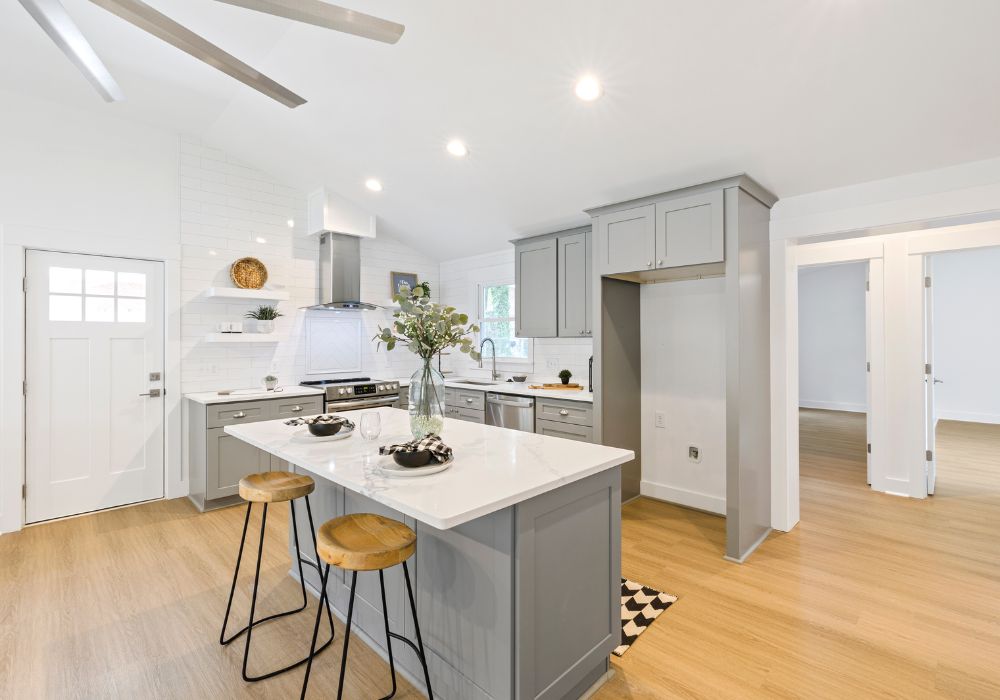The best place for a garbage can in the kitchen can go beyond mere practicality. While often overlooked, the strategic placement of this essential item can significantly impact your kitchen’s organization and atmosphere.
In this article, we explore the complexities of kitchen design, uncovering the hidden tiny details that guide you to the perfect spot for your garbage can.
This ensures that every disposal and toss seamlessly integrates into your cooking routine, enhancing functionality and aesthetics.
Where Is the Best Place To Put a Bin In the Kitchen?
The kitchen, often hailed as the heart of the home, is a space where culinary creativity flourishes, and every cooking endeavor leaves its mark in the form of peelings, packaging, and food scraps.
With this bustling activity comes the inevitable need for a garbage can, a humble yet indispensable companion in the culinary journey.
Let’s start by exploring strategic locations that keep your cooking area tidy and elevate your kitchen’s efficiency and aesthetic appeal.
See below the 12 best places to place a garbage can in the kitchen.
1. In a Pull-Out Drawer
A solution to maintain a clutter-free kitchen, placing a bin in a pull-out drawer is an excellent choice for those who appreciate the art of subtlety.
This approach keeps the garbage can neatly concealed, seamlessly allowing you to slide it out when needed.
Imagine the satisfaction of disposing of waste with a simple pull and then tucking it away, out of sight, as you continue to create culinary masterpieces.
Utilize the inner surface of a drawer to mount a small, lidded bin. This ingenious setup maximizes space and keeps the garbage can out of sight when closed.
It’s a fantastic solution for compact kitchens or those who prefer a more concealed trash disposal option.
When you open the drawer, the garbage bin is ready to receive your discarded items. This placement maintains your kitchen’s streamlined look while preventing odors from spreading.
You can easily dispose of waste without exposing it to view, contributing to a tidier and more visually appealing kitchen environment.
2. Under a Countertop
Position a garbage bin under a countertop and within arm’s reach of your food preparation area, enabling you to discard trimmings and debris without interrupting your cooking flow.
This creative design ensures that you can quickly sweep away trimmings and food scraps directly into the bin, minimizing mess and simplifying cleanup.
Imagine effortlessly sliding your food scraps from the cutting board into the waiting bin beneath. This setup saves you time and prevents potential spills or wastes from falling onto the floor.
3. Under The Sink
This choice that has stood the test of time, tucking the garbage can under the sink, remains popular. This placement is a way of optimization, utilizing the often-underutilized space beneath your sink for a functional purpose.
It’s a space-saving maneuver that ensures your garbage can is within easy reach, encouraging swift and effortless disposal as you chop, dice, and sauté your way to culinary excellence.
No more interruptions or detours to reach a distant bin – the under-sink placement facilitates a seamless workflow, enhancing your efficiency and allowing you to focus on cooking.
4. Beside the Sink
Placing the garbage can beside the sink is a practical choice for those who prefer a more visible disposal solution.
This location is convenient for quick disposal of rinsed items or food scraps while washing dishes.
The sink’s water source provides immediate access for rinsing, reducing the likelihood of mess and enhancing efficiency.
5. In A Closet
If you have a pantry or a closet in your kitchen, consider transforming a corner into a dedicated waste disposal area.
This option offers a subtle and organized solution, neatly tucking away the garbage can behind closed doors.
It’s a fantastic way to maintain a clutter-free kitchen, with the added benefit of a concealed trash can that’s easily accessible.
6. Near the Door
Strategically placing a garbage can near the kitchen exit serves two essential purposes: it caters to easy waste disposal as you exit the kitchen, and it’s a handy spot for disposing of trash during meal cleanup.
Guests and family members can quickly discard plates, napkins, and food remnants before leaving the kitchen, keeping the main cooking area tidy.
7. Tucked Into a Nook
Have you got an empty nook in your kitchen layout? Why not transform it into a designated garbage station?
With creativity, you can fashion a customized disposal space that blends seamlessly with your kitchen’s design.
This approach ensures that your garbage can is perfectly integrated functionally and aesthetically.
8. Built into a Step Stool
Innovate with a dual-purpose step stool that conceals a hidden bin. This inventive setup assists with hard-to-reach items and provides a discreet and easily accessible disposal solution right where you need it.
A step stool with a built-in bin is like having an extra hand in the kitchen. As you reach for ingredients or utensils stored on higher shelves, you can conveniently dispose of waste without interrupting your workflow.
This innovative approach saves you from stretching or searching for a separate bin, ensuring a seamless and efficient cooking experience.
9. Inside a Kitchen Cart or Trolley
A mobile kitchen cart or trolley with a built-in garbage bin can be a game-changer for kitchens with limited counter space.
This versatile solution offers storage and disposal capabilities, adapting to your cooking and cleanup needs.
A kitchen cart with an integrated garbage bin is like having an extra workstation that follows you wherever you go.
You can move your disposal solution closer to your cooking area, adapting it to your changing needs.
This setup enhances the mobility and flexibility of your kitchen, making it easy to manage waste and maintain a clutter-free environment.
10. Inside A Basket
This unassuming yet ingenious placement transforms waste disposal into a stylish affair. Using a basket as your garbage bin adds a touch of rustic charm while keeping your kitchen tidy.
It’s a fantastic option for kitchens with limited floor space, as the basket can be placed on a countertop or a lower shelf.
The tactile texture of the basket adds warmth to your kitchen’s ambiance, demonstrating that even waste management can be a design statement.
11. Mounted On A Wall
Mounting a garbage bin on a wall frees up valuable floor or counter space. This approach is particularly handy in compact kitchens where every inch matters.
A wall-mounted bin is easily accessible and can be strategically placed near your food prep area or cooking station, allowing you to dispose of waste without interrupting your culinary flow.
Additionally, the elevated placement prevents critters from getting into your garbage, maintaining a cleaner and more hygienic kitchen environment.
12. Hanging On A Sink
The convenience of having your garbage bin hanging right under your sink ensures that waste disposal is a seamless part of your kitchen routine.
It’s beneficial for scraping food scraps directly into the bin while rinsing dishes. Placing a container on the cabinet door beneath the sink creates an easily accessible solution.
This setup not only streamlines cleanup but also keeps your kitchen looking organized and clutter-free.
Read Also:
How Do I Hide the Recycle Bin In My Kitchen?
Maintaining a clutter-free and organized kitchen is a top priority for many homeowners.
While recycling is essential for a sustainable lifestyle, the visual presence of recycling bins can sometimes disrupt the clean aesthetics of your kitchen.
Fortunately, there are several ingenious ways to conceal your recycle bin without compromising your commitment to environmental responsibility.
1. Custom Cabinetry Integration
Design custom pull-out or slide-out compartments that ideally fit your recycle bin’s dimensions.
These compartments can be discreetly nestled within your existing cabinets, allowing you to slide the bin out when needed and push it back in when not in use.
2. Under-the-Sink Solutions
Consider installing specially designed pull-out bins or stackable containers that neatly fit within the cabinet space.
This placement keeps the recycle bin close to where you typically generate recyclable waste, such as during meal preparation or after unpacking groceries.
3. Integrated Kitchen Island

Incorporate a pull-out compartment or concealed shelf on one side of the kitchen island to house the bin.
This approach hides the bin and creates a centralized disposal area easily accessible from various parts of your kitchen.
4. Slide-Out Pantry Drawer
If you have a pantry with slide-out drawers, designate one of the drawers as a hidden recycle bin compartment.
This solution is advantageous if you store most of your kitchen essentials in the pantry. The hidden location ensures that the recycle bin remains out of sight while still conveniently located.
5. Built-in Recycling Station
Consider creating a dedicated recycling station for larger kitchens that blend seamlessly with your kitchen’s design.
This could involve a custom-built unit with multiple compartments for different types of recyclables. The station can mimic your cabinetry’s appearance, ensuring a cohesive and polished look.
6. Sliding Rail System
This innovative approach lets you quickly slide the bin in and out when needed. It’s a space-saving solution that ensures your recycle bin remains hidden while offering quick access.
7. Decorative Screen or Curtain
Add a decorative screen or curtain to your kitchen’s open shelving unit or alcove.
This screen can be easily pulled aside to reveal your recycle bin when needed and then discreetly closed to keep it out of sight.
8. Convertible Workstation
This compartment can be seamlessly integrated into the design of the workstation, ensuring that your recycle bin remains hidden when the workstation is not in use.
Which Is the Best Garbage Bin Type To Be Used In the Kitchen?
Selecting the perfect garbage bin for your kitchen involves considering various factors such as size, design, and convenience.
Let’s explore some of the best garbage bin types commonly used in kitchens:
- Pull-Out Bins: Offer a sleek and organized solution. These bins glide smoothly for easy access and can be configured with separate compartments for different types of waste.
- Step-On Bins: The lid opens with a simple pedal press for effortless disposal, making them ideal for busy cooks.
- Under-the-Sink Bins: Utilize under-sink space with under-the-sink bins. They’re compact, accessible, and keep waste hidden from view.
- Built-In Compactors: Compactors compress waste, reducing volume and emptying frequency—a practical choice for heavy waste producers.
- Countertop Bins: Convenient for food prep, countertop bins are compact and sit right on your kitchen counter for easy disposal.
- Slim Profile Bins: Fit into narrow areas like corners or between cabinets, perfect for tight spaces.
- Recycling Stations: Customizable recycling stations help you organize different waste types, supporting eco-friendly practices.
- Sensor-Activated Bins: Sensor-activated bins open automatically when approached, providing a hygienic, hands-free option.
How Big Should a Kitchen Garbage Can Be?
16 Gallon Stainless Steel Step Trash Can
The kitchen garbage can size depends on your household’s waste production and available space. A 12 to 16 gallons garbage can is often sufficient for an average family.
However, larger homes or those who cook frequently might opt for a 20 to 30-gallon can. It’s essential to consider your needs and kitchen layout when choosing the right size for your garbage can.












